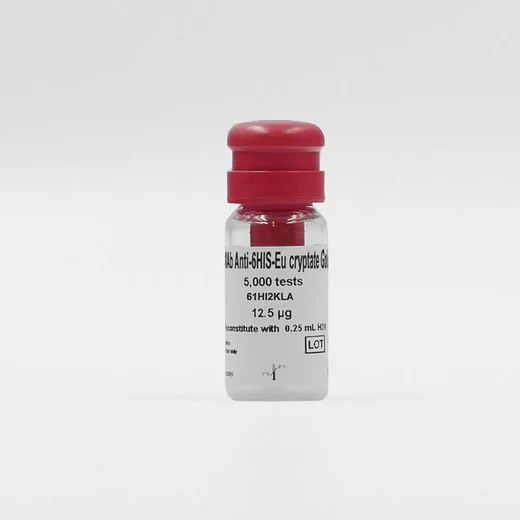

HTRF MAb Anti-6HIS-Eu cryptate Gold, 5,000 Assay Points






Eu cryptate-labeled anti-6His antibody for capturing 6His-tagged proteins in protein/protein interaction assays.
For research use only. Not for use in diagnostic procedures.
Product information
Overview
MAb Anti-6HIS-Eu cryptate Gold is a monoclonal antibody which was raised against a polyhistidine tagged fusion protein labeled with Eu. It recognizes synthetic polyhistidine or polyhistidine-tagged fusion protein.
This reagent can be used in both biochemical and cellular formats to study a wide variety of interactions: protein/protein, protein/peptide, protein/DNA, protein/RNA, protein/carbohydrate, protein/small molecule, receptor/ligand.
HTRF can detect a broad range of affinity constants ranging from picomolar to low millimolar.
Specifications
| Assay Points |
5000
|
|---|---|
| Assay Target Type |
Fluorescent reagent
|
| Assay Technology |
HTRF
|
| Brand |
HTRF
|
| Quantity |
1
|
| Therapeutic Area |
Cardiovascular
Infectious Diseases
Inflammation
Metabolism/Diabetes
NASH/Fibrosis
Neuroscience
Oncology & Inflammation
Rare Diseases
|
| Unit Size |
5,000 Assay Points
|
Video gallery


How it works
Assay principle
In an HTRF interaction assay, one partner is labeled (directly or indirectly) with the donor, and the other with the acceptor (again, directly or indirectly). The intensity of the signal is proportional to the binding of the 2 partners. In the example shown here: MAb Anti-6HIS-Eu cryptate Gold binds to the 6 His tagged partner A while partner B* binds to a specific Ab labeled with an HTRF acceptor. *partner B can also be biotinylated, tagged, Fc fused. In these cases, use the corresponding HTRF reagent (anti-Tag, anti-species, protA, Streptavidin) labeled with acceptor for the detection.

Assay protocol
The example on the right describes the protocol using a 20 µL final assay volume for detecting an interaction between a 6 His-tagged partner A and a non-tagged partner B*. Dispense the 2 partners (10 µL), incubate, add MAb Anti-6HIS-Eu cryptate Gold (5 µL) and anti-partner B labeled with acceptor (5 µL), incubate and read. *partner B can also be biotinylated, tagged, Fc fused or directly labeled. In these cases, use the corresponding HTRF reagent (anti-Tag, anti species, protA, Streptavidin) labeled with acceptor for the detection.

Assay details
How do the number of tests relate to active moiety?
The average conjugate quantity per well reflects overall biological material content. Using the active moiety amount is generally preferred to the quantity of total conjugate. For Cryptate and d2 conjugates, the total conjugate amount equals that of the active moiety, since the molecular weight of the label is negligible. This is not the case for XL665 labeled entities for which the quantity of total conjugate will vary depending on the final molar ratio of the XL665 conjugate, however, the amount of active moiety, provided by Revvity, is constant and based on the number of tests ordered.

Recommended quantities of Cryptate and XL665 conjugates
Cryptate conjugates must not be excessive in order to prevent reader saturation and an unacceptable level of background. In most cases, a cryptate concentration of 1 to 5nM is appropriate, and will generate 20,000 to 80,000 cps at 620 nm depending on the HTRF compatible reader used. The XL665 conjugate must match its assay counterpart as closely as possible in order for the maximum number of biomolecules to be tagged with the XL665 acceptor. Thus, to detect a tagged molecule at an assay concentration of 20nM, the concentration of anti-Tag-XL665 should be equimolar or higher.
Resources
This guide provides you an overview of HTRF applications in several therapeutic areas.

SDS, COAs, Manuals and more
Are you looking for technical documents for this product. We have housed them in a dedicated section., click on the links below to explore.


How can we help you?
We are here to answer your questions.






























